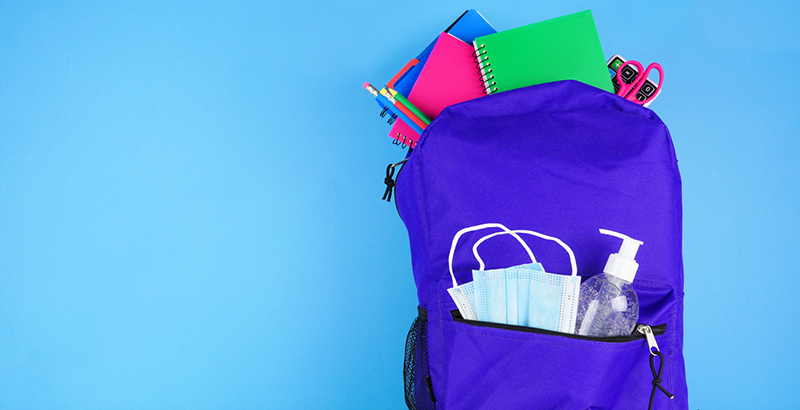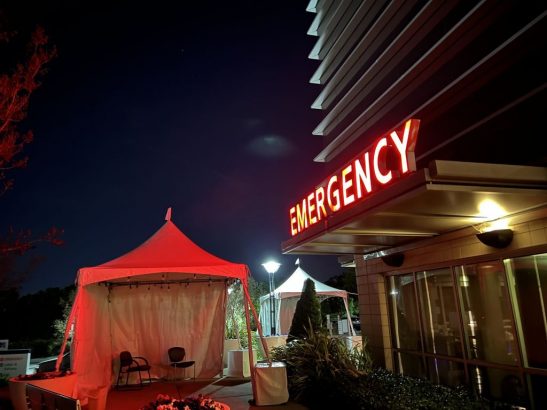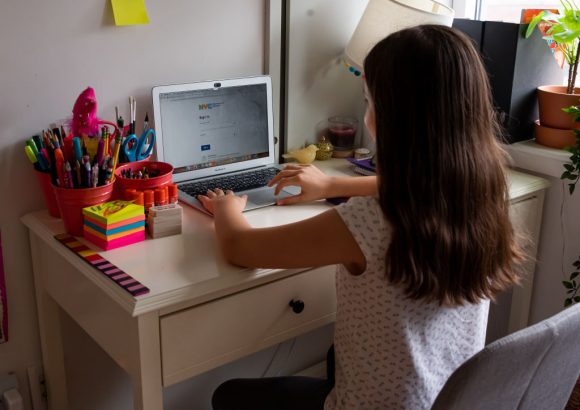This Week in Pandemic Education Policy: Hundreds of Suicidal Teens Spending Nights in Emergency Rooms, NYC Launching Public Virtual Schools & More

This is our weekly briefing on how the pandemic is shaping schools and education policy, vetted, as always, by AEI Visiting Fellow John Bailey. Click here to see the full archive. Get this weekly roundup, as well as rolling daily updates, delivered straight to your inbox — sign up for The 74 Newsletter.
Hundreds of Suicidal Teens Sleep in Emergency Rooms. Every Night: Via The New York Times.
- “At the E.R., a doctor examined [an adolescent] and explained to her parents that she was not safe to go home.”
- “ ‘But I need to be honest with you about what’s likely to unfold,’ the doctor added. The best place for adolescents in distress was not a hospital but an inpatient treatment center, where individual and group therapy would be provided in a calmer, communal setting, to stabilize the teens and ease them back to real life. But there were no openings in any of the treatment centers in the region, the doctor said.”
- “Indeed, 15 other adolescents — all in precarious mental condition — were already housed in the hospital’s emergency department, sleeping in exam rooms night after night, waiting for an opening. The average wait for a spot in a treatment program was 10 days.”
- “The girl … spent the first week of her wait in a ‘psych-safe’ room in the emergency department. She grew ‘catatonic,’ her mother recalled. ‘In this process of boarding, we broke her worse than ever.’ ”
- “Nationally, the number of residential treatment facilities for people under the age of 18 fell to 592 in 2020 from 848 in 2012, a 30% decline.”
- “Absent that option, emergency rooms have taken up the slack. A recent study of 88 pediatric hospitals around the country found that 87 of them regularly board children and adolescents overnight in the E.R. On average, any given hospital saw four boarders per day, with an average stay of 48 hours.”

The Big Three — May 13, 2022
FDA Updates Congress on Vaccines for Children Under 5: Frustrated by the lack of information related to vaccines for under-5s, Rep. James Clyburn of South Carolina summoned the Food and Drug Administration to Capitol Hill for a briefing and shared what he learned:
- The FDA’s Peter Marks told Congress that although the adult vaccines had to meet a 50% threshold for efficacy against COVID-19 infections, that same standard will not need to be met for the vaccines for the youngest group of children: “If these vaccines seem to be mirroring efficacy in adults and just seem to be less effective against Omicron like they are for adults, we will probably still authorize.”
- If FDA is able to complete its reviews of the Moderna or Pfizer pediatric vaccines faster than anticipated, the agency would move up the meetings of the Vaccines and Related Biological Products Advisory Committee, currently scheduled in June.
- FDA won’t wait for Pfizer before starting to review Moderna.
- “Marks also said that the emergence of new variants — including Delta and Omicron — has made the process of reviewing vaccines more complex and time-consuming. He acknowledged that it ‘was a little simpler for the original submissions in late 2020, when we didn’t have the variants and tons of immunogenicity data to go through,’ which has made review and authorization of the vaccines for young kids ‘reasonably complicated.’ ”
- Emily Oster summarizes where things stand.

New York: NYC to launch two full-time virtual schools, Chalkbeat reports.
- “City officials told local lawmakers that launching the ‘full-time’ virtual schools will be part of the solution to high rates of chronic absenteeism and re-engaging students in the wake of pandemic disruption.”
- “ ‘I believe that virtual learning is here to stay whether or not we have a pandemic,’ schools Chancellor David Banks said.
- “Creating separate virtual schools may help overcome one of the key problems with virtual learning during the pandemic: The task fell to individual schools to figure out how to simultaneously staff in-person and remote classrooms. Standalone virtual schools that rely on separate teaching staff would ease that burden, though it’s not clear if that is the model officials are planning.”
Affordable Connectivity Program: The White House said 20 internet service providers have agreed to offer $30 high-speed internet plans to low-income families, effectively giving free service to households that qualify for a federal subsidy under the Affordable Connectivity Program.
- “The Affordable Connectivity Program provides a $30 monthly discount on internet service from participating providers for low-income households, such as those that receive federal assistance through SNAP or Medicaid.”
- “The 20 ISP companies cover more than 80% of the U.S. population, but they are a fraction of the more than 1,000 providers participating” in the program.
- Great to see Propel is helping its 5 million households sign up for the benefit.
- White House fact sheet
- New signup website: www.getinternet.gov
Federal Updates
Federal Communications Commission: Chairwoman Jessica Rosenworcel circulates ruling to make Wi-Fi on school buses eligible for E-Rate funding.
Institute of Education Sciences: Released Revenues and Expenditures for Public Elementary and Secondary Education: Fiscal Year 2020.
National Telecommunications and Information Administration: Released data from its 2021 Internet Use Survey showing “that historically less-connected communities used the Internet and connected devices in greater numbers than they did two years ago. Despite that progress, the substantial disparities that [the administration] has tracked for decades continued to be evident, highlighting the urgent need to work toward digital equity in the United States.” More via Data Explorer tool.
City & State News
Arizona: New report and press release from A for Arizona, “Transportation Modernization & Innovation Grants to Eliminate Access Barriers” which touches on everything from policy flexibility to “micro transit needs” to grants for families.
California:
- The Los Angeles Board of Education unanimously approved a delay of a student vaccine mandate for COVID-19 that had been scheduled to take effect next fall, under a recommendation from Superintendent Alberto Carvalho.
- California Department of Technology released its draft map and design recommendations for a proposed statewide broadband middle mile network. The map outlines nearly 9,000 miles of infrastructure intended to serve as a backbone for connection projects to underserved and unserved communities throughout the state.
Colorado: U.S. deputy secretary of education visits Aurora Public Schools with eye on mental health efforts.
Massachusetts: Virtual schools approved for another year.
New Hampshire: “The Yes, Every Student (YES!) scholarship program is designed to help families and residents whose education was negatively impacted by the COVID-19 pandemic by awarding $1,000 tutoring scholarships to New Hampshire students, which includes public, non-public, home education and Education Freedom Account students. It is the second year in a row the Department of Education has offered the scholarships.”
Tennessee:
- After an extensive battle, an appeals court ruled that K-12 mask mandates are legal despite a state law trying to prohibit their use.
- Nearly 3 in 10 Memphis-Shelby County Schools students were chronically absent from school this year — a jump of almost 10 percentage points over pre-pandemic years.
COVID-19 Research
Moderna:
- Said it has made all necessary submissions required by the FDA for emergency use authorization of its COVID-19 vaccine in adolescents and children.
- “The company is seeking approval for the use of its vaccines in three distinct age groups — adolescents aged 12 to 17 years, children aged 6 to 11 and those between 6 years and 6 months.”
- “Submissions for all three groups were made May 9.”
- Study on effectiveness in children 6-11:
- “Estimated vaccine efficacy was 88% against COVID-19 occurring 14 days or more after the first injection, at a time when B.1.617.2 (Delta) was the dominant circulating variant.”
- “The effectiveness of the mRNA-1273 vaccine in the trial shown during the Delta variant outbreak in the United States and preliminary results that show neutralization of the Delta variant suggest that the vaccine can provide a protective benefit in children against variants, findings that are consistent with those of other studies. However, the trial was conducted before the surge of the Omicron variant, and assessment of the benefit of the vaccine against this variant is ongoing in the trial.”
As Absenteeism Skyrockets, Schools Get Creative About Luring Back Lost Students: Via The 74.
- “Chronic absenteeism has hit 40% in the nation’s two largest districts, New York City and Los Angeles, and is reaching dangerously high numbers in many districts in between.”
- “The issue has fueled creative approaches to reminding parents of the importance of keeping their children in school. Staff members recently gathered at a local Baptist church as part of their newest strategy — offering information on COVID vaccines, housing and transportation assistance in hopes of pinpointing the reasons children miss school. Families whose children have at least half a dozen absences were more likely to get an invitation or a knock on the door, urging them to attend the event.”
Freshmen, Held Back During Pandemic, Fuel ‘Bulge’ in 9th Grade Enrollment: Via The 74.
- “With many young children who delayed pre-K and kindergarten during school closures now flooding back into the education system, an enrollment surge in the early grades was expected. But 15 states and D.C. saw growth in ninth grade of at least 5% compared to 2020-21, and in a few states, including New Mexico and North Carolina, the increase in freshmen far outpaced that of kindergartners.”
- “Retention data in some states and districts back that up. Figures from last fall show that 18% of ninth graders in the Houston Independent School District repeated the year, significantly higher than the district’s pre-pandemic rate of 10%. And in North Carolina, more than 16% of last year’s freshman class was retained — roughly double the rate of past years.”
Routine Saliva Testing for SARS-CoV-2 in Children: Study.
- “At-home saliva collection in young children is a less invasive option than nasal/nasopharyngeal swabs, especially when accompanied by written instructions for parents/guardians. The completion of the collection by parents/guardians and their children reduces the requirement for interaction with health care workers, lowering the danger of nosocomial infection and eliminating a primary cause of testing bottlenecks. It also eliminates the requirement for supplies like nasal swabs and personal protective equipment.”
Lessons Not Learned: The Disaster of COVID-19 School Closures: Via Alasdair Munro, senior clinical research fellow in pediatric infectious diseases at University Hospital Southampton.
- “It became apparent surprisingly quickly that children had not played a key role in the initial transmission of the SARS-CoV-2 virus, and were not superspreaders in the way they are thought to be with influenza. By the spring of 2020 many European countries had prioritized the reopening of schools, and none of them experienced an early resurgence in cases of COVID-19 nor a rise [in] severe illness.”
- “There is no question that prolonged school closures are one of, if not the single most, harmful non-pharmaceutical intervention at a population level.”
- “It is vital that schools are considered essential infrastructure for any future pandemic planning.”
FDA Limits Use of Johnson & Johnson’s COVID-19 Vaccine: Citing clotting risk. FDA press release. More via Stat.
- “Going forward, the single-dose vaccine will only be available to people 18 and older who cannot take one of the other available vaccines for medical reasons, or who simply will not agree to be vaccinated with one of the messenger RNA vaccines made by Moderna and by Pfizer and its partner BioNTech.”
Mix-and-Match mRNA Vaccines May Offer More Omicron Protection: Study.
Kids’ Odds of Spreading COVID-19 in Households Rising With New Variants: Study.
Evidence Mounts for Need to Study Pfizer’s Paxlovid for Long COVID: Additional reports of patients with long COVID who were helped by Paxlovid offer fresh impetus for conducting clinical trials to test the medicine for the debilitating condition, Reuters reports.
Bill Gates on School Closures: “It’s pretty clear, because young people don’t get sick from the disease very often, that we probably, if we knew everything we know today, we would have shut schools down a lot less than we did during this pandemic.”
Remembering the 1 Million Lives Lost: The bells of the Washington National Cathedral toll 1,000 times in memory of the 1 million people who have died from COVID-19.
Viewpoints
Teens, High School Parents and Their Perspectives on the Pandemic: Via EdChoice. Report / Teens Crosstabs / High School Parents Crosstabs
- “High school parents and teens express very different outlooks about the future. Parents are more optimistic about their child’s future, while teens are more likely to feel neutral, potentially indicating either uncertainty or indifference. High school parents are more likely to believe that their child is ready for life after high school than teens feel they are — especially those planning on attending college.”
- “About half of teens still plan on attending college after high school, despite the pandemic’s influence. However, many teens stated they are a little less inclined to do so now compared to their pre-pandemic plans. One out of five high school parents said their child’s post-high school plans have changed during the pandemic.”
- Related: How Has the Pandemic Affected High School Graduation and College Entry? Via Brookings
As Students Struggled to Learn, Teachers Reported Few Strategies as Particularly Helpful to Mitigate Learning Loss: New GAO report.
- 60% of virtual learning teachers said their students had more difficulty understanding lessons;
- 61% of teachers had more students who experienced emotional distress;
- 85% of in-person teachers said live instruction – either fully or partially in person – helped students;
- Fewer than 40% of teachers thought asynchronous learning helped a majority of their students.
We Parents of Unvaccinated Children Need More Guidance: Via Nita Farahany in the Washington Post.
- “We parents of young children who can’t be vaccinated feel abandoned at this late stage of the pandemic. Federal officials, it seems, have decided to leave it up to us to figure out how to navigate coronavirus risks for our children. This lack of information has bred distrust in parents while putting public health agencies in an unenviable Catch-22 as they prepare to — finally, hopefully — vaccinate children under 5.”
New Education Policy Roadmap Aims to Ensure High School Graduates in Every State are ‘Future-Ready’: Civic, CASEL and the Coalition for Career Development Center share recommendations for policymakers.
Not Good for Learning: “New research is showing the high costs of long school closures in some communities,” The New York Times reports.
Teachers Believe Whole-Child Learning Gives Students the Skills Needed to Succeed: Gradient Learning has released results from a national survey, indicating 91% of teachers believe students perform better when schools prioritize whole-child learning.
…And on a Reflective Note
- Beating the Odds: Rich Strike, an 80-1 longshot, pulled off the second-biggest upset in the Kentucky Derby’s 148-year history. The overhead view is even more impressive.
- Never Give Up: This has to be the comeback of the century. She lost her shoe coming out of the starting blocks, and then wait for it …
She lost her shoe coming out of the starting blocks.
Wait for it… pic.twitter.com/60SKGKpz4g
— Rex Chapman?? (@RexChapman) May 9, 2022
ICYMI @The74
Weekend Reads: In case you missed them, our top stories of the week:
- Weaving a Stronger Society: Helping First-Generation Students Reach College — and Build Community on the Way
- Minneapolis: The Teacher Strike Lasted 3 Weeks. The Fallout Will Be Felt for Years
- 74 Interview: David Brooks Talks Education, Cultural Divides and How the Weavers in our Schools Will Help Heal America
For even more COVID policy and education news, subscribe to John Bailey’s daily briefing via Substack.
Disclosure: John Bailey is an adviser to the Walton Family Foundation, which provides financial support to The 74.
Get stories like these delivered straight to your inbox. Sign up for The 74 Newsletter

;)
